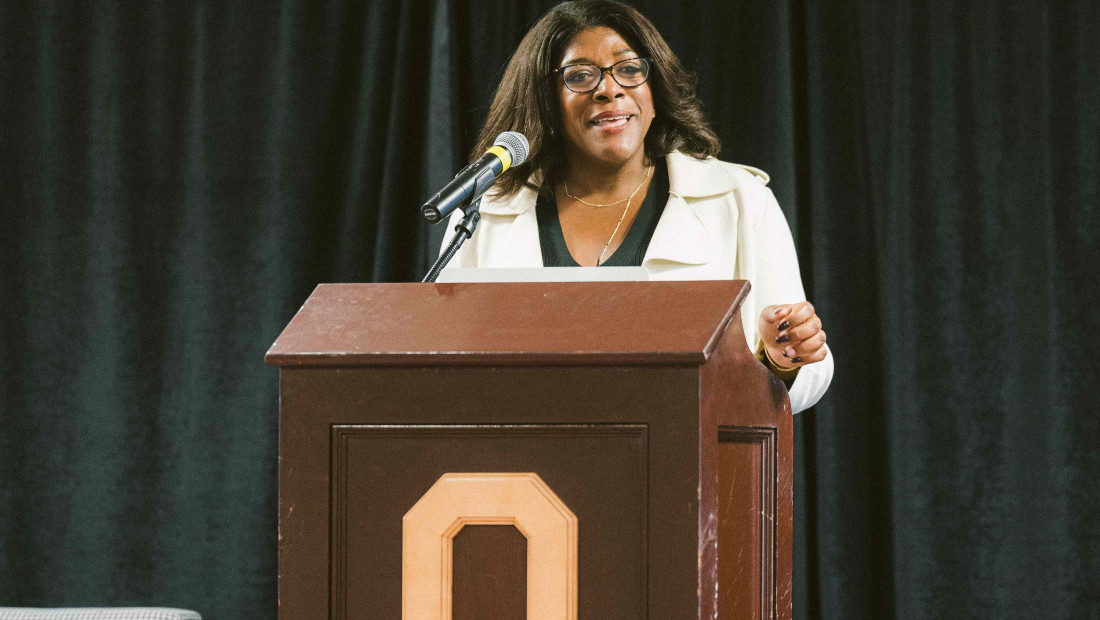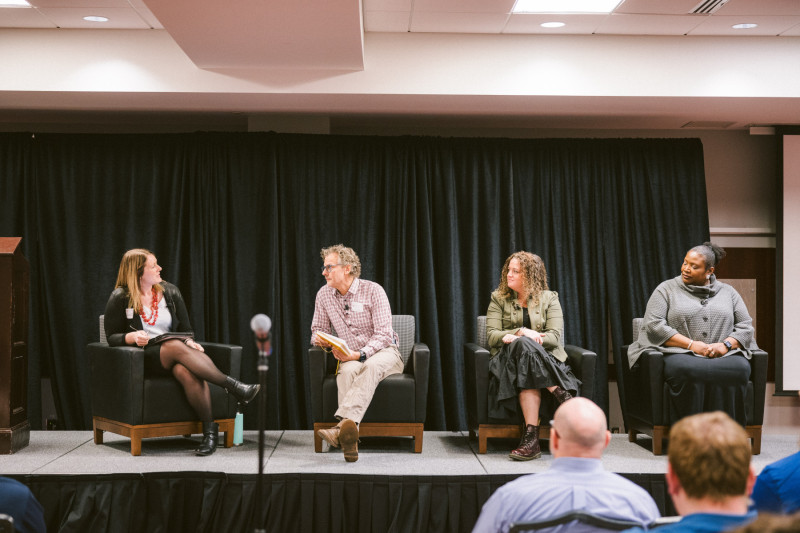
Detra Price-Dennis, executive director of Ohio State's Center for Digital Learning and Innovation.
In conjunction with the launch earlier this year of the new Center for Digital Learning and Innovation, The Ohio State University College of Education and Human Ecology (EHE) presented the inaugural Fostering Innovation and Creativity with Technology in K-12 Education symposium on Oct. 17 at the Ohio Union.
The symposium brought together educators, administrators and information technology specialists to discuss how coding, data analytics, virtual reality and other technologies impact teaching and learning. EHE presented the event in partnership with Apple as part of its Community Education Initiative.
“This is the first of many conversations to come,” said Nicole Luthy, EHE chief of staff and director of strategic operations, in welcoming attendees on behalf of Dean Don Pope-Davis. “You’re now part of our community, and we want that community to be vibrant, to thrive and to push innovation skills.”

The Center for Digital Learning and Innovation seeks to advance digital learning through innovation in research, teaching and learning. Detra Price-Dennis, an EHE professor and the center’s executive director, said the symposium’s purpose is to increase collaboration between educators and administrators at the K-12 level and those in higher education.
“With this center, we really need to be seen as a hub,” she said. “We can bring people together. We can have authentic conversations with people about what’s happening and what’s going really well and what they want to lift up and show other people, and what they need support with.”
In his keynote address, Ian O’Byrne, associate professor of education at the College of Charleston, offered insights on how educators can use technology to prepare students for careers that don’t yet exist.
“I do a lot of research in my local area around computational thinking – not really coding or programming, but what are the skills and steps and habits that get you to that spot where you can start coding?” he said. “Also, one of the components that is a focus here is project-based learning, design thinking and how can we have students in our classrooms think outside the box? Put simply, we need to create students that are lifelong learners.”
The symposium included workshops and panel discussions with Ohio State faculty and staff and educators from across Ohio and the nation. The morning panel centered on how higher education leaders can work more closely with their K-12 counterparts to ensure that teachers enter the workforce with the skills to adapt to ever-changing technology.
“What are the tools that I need to give our folks for them to be their most creative and their most innovative?” said Sherri-Ann Butterfield, executive vice chancellor and associate professor at Rutgers University. “Sometimes that is helping them to figure out how to change the curriculum. Sometimes it’s helping them to try to figure out how to change policies. … What can the university do to help you to do better?”

The afternoon panel focused on the most effective ways to incorporate technology in the classroom.
While the seemingly infinite number of choices can be overwhelming, technology also gives teachers more options in addressing students’ specific needs, said Charles Lang, executive director of the Digital Futures Institute at Columbia University’s Teachers College.
“At some point in the last 10 years … there was an inflection point where the number of what I call (technology) formats started to go up. You had choices, and now you can make creative choices with those formats,” he said. “I think now we’re finally getting to the point where we can start to look at an individual student on the same content, but across different formats. And that’s new and that’s exciting.”
Parents and educators play an essential role in helping students navigate artificial intelligence (AI) such as ChatGPT and other emerging technologies, said Aman Yadav, a professor of computing education at Michigan State University.
“Even if ChatGPT does revolutionize education, who’s it going to benefit? Not the kids who are marginalized in our society already,” he said. “Because to be able to make sense of what ChatGPT spews out, you still need to have expertise and knowledge … to make kids make sense of that information.”
Technology should be viewed as a tool to help educators bolster their creativity, said Ana-Paula Correia, professor of learning technologies at the College of Education and Human Ecology.
“Technology in itself is not going to foster creativity,” she said. “As teachers, educators, and instructional designers, it is our imagination that will help us realize how we can use technology to expand its benefits and achieve the goal of teaching, which is to help someone learn better.”
Also during the symposium, participants visited the College of Food, Agricultural and Environmental Science’s 4-H Mobile Design Lab. The 35-foot bus is a mobile classroom that travels Ohio, enabling K-12 students to learn skills in science, technology and the arts.
At the symposium’s conclusion, Price-Dennis said the Center for Digital Learning and Innovation will process feedback from participants about issues they would like to further explore. Based on that feedback, the center will present webinars throughout the current school year and tailor content for next year’s symposium.
For more information, visit the Center for Digital Learning and Innovation’s website.
